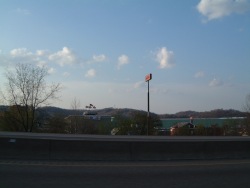|
In September of 2025, my work is generating the most income it ever has in my career. Yet, I'm being forced to shut down my successul operation, against my will, due to one cause alone: 95% of that revenue is being stolen by piracy and copyright infringement. I've lost more than $1 million to copyright infringement in the last 15 years, and it's finally brought an end to my professional storm chasing operation. Do not be misled by the lies of infringers, anti-copyright activists and organized piracy cartels. This page is a detailed, evidenced account of my battle I had to undertake to just barely stay in business, and eventually could not overcome. It's a problem faced by all of my colleagues and most other creators in the field. |
Have you ever thought about it? You know, what's coming after this is all over? You probably spend a lot of time, money and resources planning for your future. But what about your real future - the one that you will have after this life is over? It would be very wise to take some time to make sure that you're on the road to the right place. There's an easy way to find out.
It's only April, but this year the skies are already beginning to come alive. At 7:45pm, radar showed several intense thunderstorms in eastern Ohio moving slowly east toward the state line at Parkersburg. I immediately packed up and headed north on I-77. Near Tuppers Creek, the sun was low on the western horizon, casting a relaxing orange glow above the mountains. This is what makes the chase almost as enjoyable as the storm.
By 8:45pm, the lightning was just beginning to become visible through the haze in the fading daylight near Ripley. My target storm was an isolated cell that was drifting due east just south of Parkersburg. By 9:00pm I was finally in front of it.
I exited the highway at Medina Road just north of Ripley, and continued along the dark, rural road looking for a setup location. Meanwhile several breathtaking, sky-filling anvil crawlers burst across the sky overhead.
I finally found a nice view facing west along the road about 5 miles from the interstate, and set up the three cameras.
At the counsel of other lightning photographers that I regularly correspond with on the lightning mailing list, I was shooting FujiChrome Sensia 100 slide film for the first time, instead of the usual Kodak 100. I knew that the camera had caught the anvil crawler in the first photo at right, but I wasn't sure about the rest of the strikes. It turned out that the slide film did a decent job of catching even the fairly distant ground strikes (last three photos). These would have been definate throw-away photos on 100 speed print film. In other words, I'm using slide film from now on!
The second and fourth photos show the most unusual-looking cloud-to-ground strikes I've ever seen, at a distance of about 3 miles. They both seem to have at least four (or more) ground connections apiece.
My good friend Bill Coyle from Virginia Beach, VA, also an avid lightning photographer, happened be in West Virginia this night on a business trip in Morgantown. He, along with another friend, managed to get in front of a nice cell in this same line of storms near Fairmont, at the small airport near Kingmont Road. It turns out that there were three of us shooting Mountain State lightning at the same time only 70 miles apart. Bill's slides are still getting developed.
 AT LEFT: Looking north along Interstate 64 at 7:55pm in South Charleston. The high cirrostratus clouds visible in the distance are being carried far eastward from the 'anvil' tops on the thunderstorms in eastern Ohio, due to upper-level winds.
AT LEFT: Looking north along Interstate 64 at 7:55pm in South Charleston. The high cirrostratus clouds visible in the distance are being carried far eastward from the 'anvil' tops on the thunderstorms in eastern Ohio, due to upper-level winds.
BELOW: Manual 'reflex' shot of a West Virginia anvil crawler at 9:30pm with the digital camera, the first lightning bolt caught on this camera. Obviously this camera won't get the priority in shooting most storms, but it's good to know it can at least catch something.

Camera/Lens/Film/Exposure: Tripod-mounted Pentax K1000 SLR, 28mm lens at F5.6, FujiChrome Sensia 100 at 20 to 30 second exposures.
Video: Tripod-mounted Panasonic VHS-C Palmcorder PV-L857
Digital Camera: Handheld Fuji FinePix 4.7 Megapixel, on auto-night exposure mode